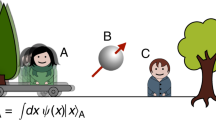No Heading
The canonical twin paradox is explained by making a correct use of the principle of equivalence. The role of the principle of equivalence is to provide a physical agent i.e gravity which can supply the required extra aging to the rocket-bound sibling during its acceleration phase through a gravitational time-offset effect. We follow an approach where a novel variation on the twin paradox is used to connect gravity with the desynchronization in the clocks of two spatially distant, identically accelerated observers. It is shown that this approach removes certain drawbacks of an earlier effort which claims to exploit the equivalence principle in explaining the differential aging in the paradox.
Similar content being viewed by others
References
1. A. Einstein, The Meaning of Relativity, 5th edn (Princeton University Press, NJ, 1955).
2. C. M. Will, “The renaissance of general relativity,” in Paul Daveis, ed. The New Physics (Cambridge University Press, Cambridge, 2000).
3. R. V. Pound and G. A. Rebka, Phys. Rev. Lett. 4, 337–341 (1960).
4. R. V. Pound and J. L. Snider, Phys. Rev. B 140, 788–803 (1965).
5. A. Harpaz, Eur. J. Phys. 11, 82–87 (1990).
6. M. Redhead and T. A. Debs, Am. J. Phys. 64(4), 384–392 (1996).
7. P. Pesic, Euro. J. Phys. 24, 585–589 (2003).
8. Special Relativity Theory–Selected Reprints (American Institute of Physics, New York, 1959).
9. R. H. Romer, Am. J. Phys. 27, 131–135 (1959).
10. D. Bohm, The Special Theory Of Relativity (Benjamin, New York, 1965).
11. E. A. Desloge and R. J. Philpott, Am. J. Phys. 55, 252–261 (1987).
12. R. P. Gruber and R. H. Price, Am. J. Phys. 65(10), 979–980 (1997).
13. T. Dray, Am. J. Phys. 58(9), 822–825 (1990).
14. C. H. Brans and D. R. Stewart, Phys. Rev. D 8(6), 1662–1666 (1973).
15. H. Bondi, “The space traveller's youth,” in Special Theory Of Relativity–Selected Reprints. (American institute of Physics, New York, 1963).
16. W. Rindler, Essential Relativity 2nd edn. (Spinger, New York, 1977).
17. C. W. Misner, K. S. Thorne, and J. A. Wheeler, Gravitation (Freeman, San Francisco, 1973).
18. C. Kacser, Introduction to The Special Theory Of Relativity (Prentice-Hall, New Jersy, 1967).
19. S. P. Boughn, Am. J. Phys. 57(9), 791–793 (1989).
20. E. A. Desloge and R. J. Philpott, Am. J. Phys. 59, 280–281 (1991).
21. R. H. Price and R. P. Gruber, Am. J. Phys. 64(8), 1006–1008 (1996).
22. R. H. Barron and P. Mazur, Am. J. Phys. 44(12), 1200–1203 (1976).
23. E. Zahar, Brit. J. Phil. Sci. 28, 195–213 (1977).
24. S. K. Ghosal, D. Mukhopadhyay, and Papia Chakraborty, Eur. J. Phys. 15, 21–28 (1994).
25. S. K. Ghosal, K. K. Nandi, and P. Chakraborty, Z. Naturforsch 46a, 256–258 (1991).
26. T. Sjödin, Nuovo Cimento B 51, 229–245 (1979).
27. S. K. Ghosal, Biplab Raychaudhuri, Anjan Kumar Chowdhury, and Minakshi Sarker, Found. Phys. 33(6), 981–1001 (2003).
28. S. K. Ghosal, Biplab Raychaudhuri, Anjan Kumar Chowdhury, and Minakshi Sarker, Found. Phys. Lett. 17(5), 457–478 (2004).
29. R. Perrin, Am. J. Phys. 47(4), 317–319 (1979).
30. B. F. Schutz, A First Course In General Relativity (Cambridge University Press, Cambridge, 1985).
Author information
Authors and Affiliations
Corresponding author
Additional information
* Author to whom all correspondences should be made.
Rights and permissions
About this article
Cite this article
Ghosal*, S., Nepal, S. & Das, D. The Principle of Equivalence and the Twin Paradox. Found Phys Lett 18, 603–619 (2005). https://doi.org/10.1007/s10702-005-1315-0
Received:
Revised:
Published:
Issue Date:
DOI: https://doi.org/10.1007/s10702-005-1315-0




